Life in the Deep Sea
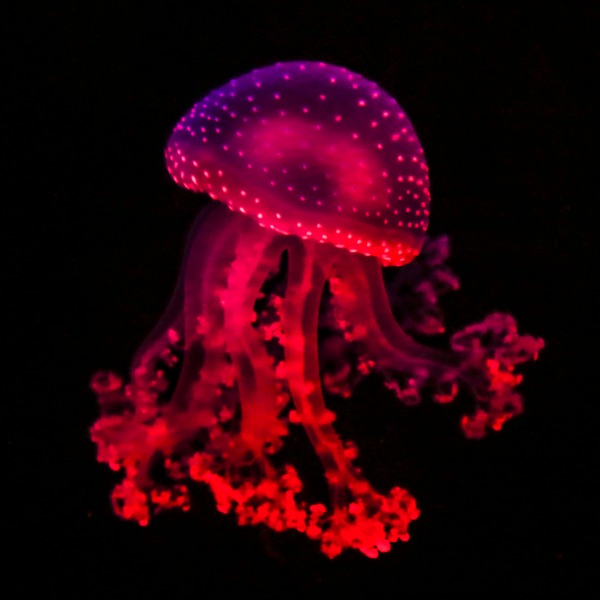
Red jellyfish (GoodLifeStudio, iStockphoto)

Red jellyfish (GoodLifeStudio, iStockphoto)
How does this align with my curriculum?
Learn about the unique creatures that live in deep sea ecosystems.
What is the Deep Sea?
The deep sea is the lowest layer of the ocean and is home to the most hostile conditions on Earth. There is no light, the pressure is extreme, and the temperatures are near freezing. But that is still not enough to stop life! Follow us as we dive into those waters and discover the amazing of living beings in deep sea ecosystems.
How deep is the ocean really? This Incredible Animation Shows How Deep The Ocean Really Is
Did you know?
The deep sea takes up most of the space on the planet. This makes the deep-pelagic habitat the Earth׳s largest habitat by volume and the deep-benthic habitat the Earth’s largest habitat by area.
Who lives in the deep sea?
There are two types of deep-sea organisms:
- organisms are those that spend most of their lives on the ocean floor. Some benthic organisms, like lobsters and crabs, can freely move around on the ocean floor. Others, like anemones, attach themselves to the ocean floor. Examples of Benthic organisms in the deep sea include:

Image - Text Version
Shown are three colour photographs of benthic organisms. On the far right is a crab. It has extremely elongated front claws. It is a pale pink colour. The legs appear to be covered in hairs making it look furry. The centre photo is of a group of tube worms. The part of the worm that connects to the sea floor looks like a white tube. At the end of each tube is a dark pink shape that looks like an oval folded in half. The photo on the right is of a black coral. It is a highly branched coral that is white. The name comes from the trunk of the coral which is covered in polyps.
- organisms are those that spend their lives in the water itself. Pelagic fish actively swim in the. Other organisms, like, mainly just float around. Examples of Pelagic organisms in the deep sea include:
- Whales
- Giant Squid
- Lantern Fish
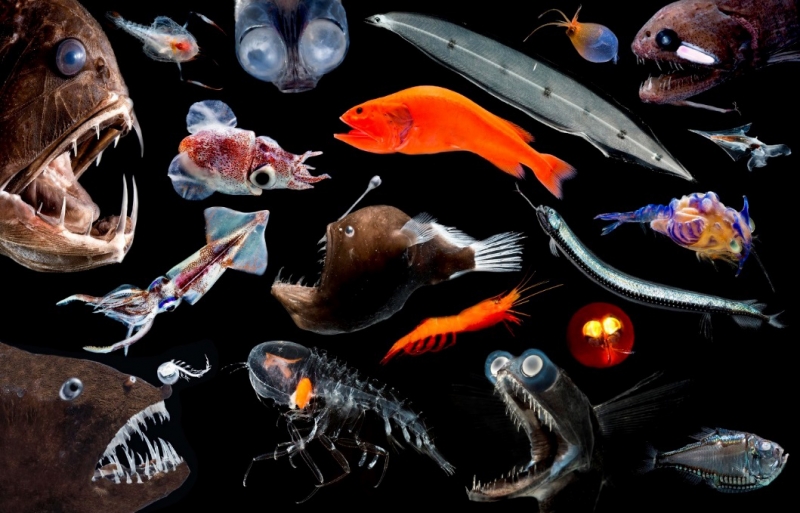
Image - Text Version
Shown is a colour photograph montage of a large variety of deep sea animals. Many of the fish have very large eyes and many large, pointy teeth. The fish are transparent, brownish and in some cases orange. Invertebrates such as squids of different shapes and sizes and jelly-like creatures are also shown.
Explore the deep sea and the creatures that live in this ecosystem here!
How do Animals Survive in the Deep Sea?
Benthic and pelagic organisms survive hostile conditions in the deep sea. This is why they need special adaptations to find food, get around, withstand pressure and survive the cold. Let’s see just how they do it!
Finding Food
So how do animals find food so far underwater? Without sunlight and in the deep-sea, living plants are not available as food. Instead, deep-sea organisms feed on bits of dead plants, dead animals and animal wastes that fall from above. This food source is known as marine snow.
Another way that some microorganisms have adapted to find food in the deep sea is to create their own! Similar to the process of photosynthesis, these organisms convert energy from chemical reactions into nutrients. This process is called .
Other fish are . They lure in with their bioluminescent lures (see below). When this happens, deep-sea fish stretch their stomachs. This means they can eat organisms up to 3 times their own size! Also, once in a while, deep-sea animals get lucky when a whale carcass sinks to the bottom of the deep sea.
Adapting to Darkness
If you have been to the ocean or seen a film of the ocean, it may seem like a pretty bright place. But this is only the topmost layer of the ocean called the Sunlight Zone. Below around 200 metres it starts to get dark and the sunlight is too weak for any plants or to survive. This zone is called the Twilight Zone and is the uppermost zone of the deep sea.
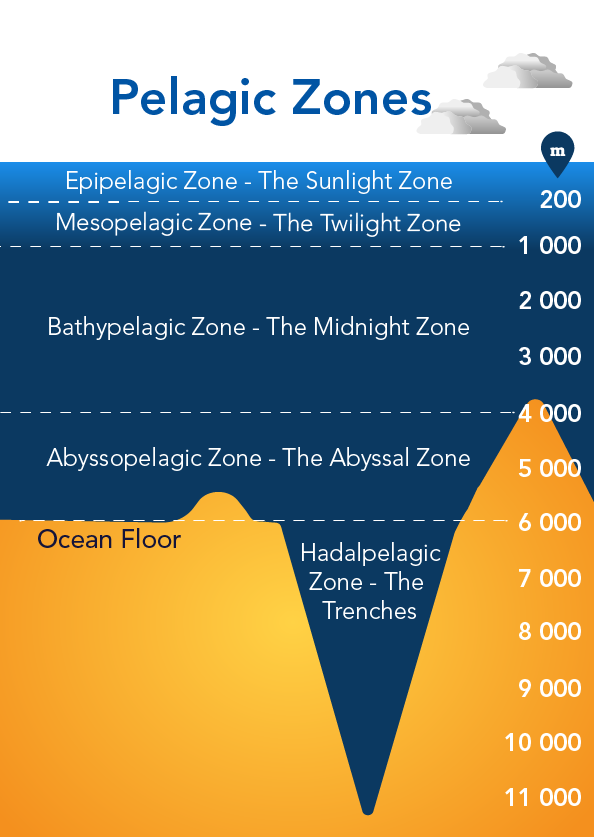
Image - Text Version
Shown is a diagram of a cross section of land and water of the ocean. This diagram focuses on the water, known as the Pelagic Zone.
The topmost layer of the Pelagic Zone is the Epipelagic or Sunlight Zone. It goes down 200 metres. Below that is the Mesopelagic or Twilight Zone. It goes from 200 to 1 000 metres. Below this is the Bathypelagic or Midnight Zone. IT goes from 1 000 to 4 000 metres. Below this is the Abyssopelagic or Abyssal Zone. It goes from 4 000 to 6 000 metres. The deepest part of the ocean is the Hadalpelagic Zone. It is also known as the trenches. It goes from 6 000 to approximately 11 000 metres.
Most of the organisms that live in the twilight zone migrate up to the sunlight zone to feed at night. They then retreat to the safety of deeper waters before daybreak. This is called vertical migrationMost of the organisms that live in the twilight zone migrate up to the sunlight zone to feed at night. They then retreat to the safety of deeper waters before daybreak. This is called vertical migration.
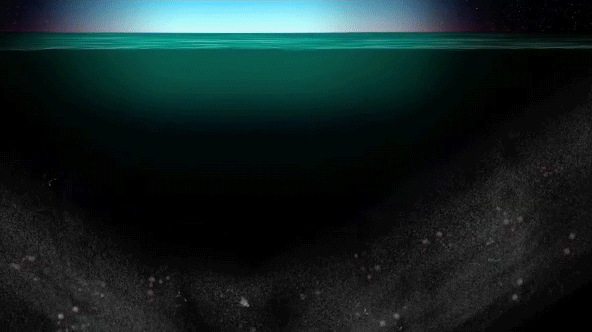
Animation showing the daily pattern of migration of some animals of the Twilight Zone (Source: Public domain by NASA via Wikimedia Commons).
Image - Text Version
Shown is an animation of the patterns of migration of some animals in the Twilight Zone of the deep ocean.
Most of the picture is almost black. This is the ocean. Light from the Sun appears as a blurry light blue area above and just below the surface of the ocean. A swirly gray pattern in the ocean moves up and down like a wave as if to follow the Sun. This pattern represents the animals that undergo vertical migration.
In order to see in the darkness below 200 meters, some deep sea animals have very big eyes! Their highly light-sensitive eyes are adapted for sensing even the smallest amount of light. A good example is the Barreleye fish. But don’t be fooled, what looks like his eyes are body parts similar to nostrils. Its eyes are the round green balls within its transparent head.
Aside from big eyes, about 90% of the animals that live in the deep sea are . Bioluminescence is the ability of an animal to emit light. A group of bioluminescent land animals you might know are fireflies.
Bioluminescence is used by animals for a number of different purposes including:
- For communication;
- To scare off predators;
- To attract prey; and
- To attract potential mates.
Most bioluminescent fish produce a bluish-green light. These short of light can be most easily seen in both shallow and deep water. Longer wavelengths of light, such as red, cannot reach the deep ocean. This is why many deep sea animals are red. It makes them harder to spot!
Watch this video to learn about a fish that has adapted to produce red light!
Adapting to Pressure
Have you ever felt your ears pop when you swam to the bottom of a swimming pool? This is because the water and air above you creates pressure. The same thing happens in the ocean. The deeper you go in the ocean, the higher the pressure. Animals that live in these high pressure environments need to have some special adaptations.
Fish that swim in the Sunlight Zone usually have a filled with gas to control their. Fish control their ability to go up and down by controlling the amount of gas in their swim bladders.
When fish go down beyond the Sunlight zone, water pressure increases. This pressure squeezes the fish’s body including its swim bladder. The increased pressure on the gas in the bladder causes a decrease in volume. This is Boyle’s Law. With less volume keeping them up, fish would sink. So how do these fish go up and down? Some put more oxygen in their swim bladders, others use fats instead of gas to adjust their buoyancy.
Whales Under Pressure
Did you know?
Some whales can dive down up to 3 000 metres. How do they do it?

Image - Text Version
Shown is an infographic of record breaking whale dives. Colour illustrations of various whales are shown.
On the left hand side of the image are depths indicated in 1 000 foot increments. They start at 5 000 feet and go to 10 000 feet. On the right side of the image are depths indicated in 500 metre increments. They start at 1 500 metres and go to 3 000 metres.
At the 1 600 metre mark is an illustration of a Blainville's Beaked Whale. This fairly small dolphin-like whale is gray with white spots on top with a white belly.
At the 1 780 metre mark is an illustration of a Baird's Beaked Whale. This is another small dolphin-like whale. It is similar to the Blainville's Beaked Whale, only its gray is a lighter shade.
At the 2 250 metre mark is an illustration of a Sperm Whale. This very large pale gray whale has a deep, rectangular head and a thick body.
At the 2 339 metre mark is an illustration of a Northern Bottlenose Whale. This dolphin-like whale is gray with pale gray splotches. LIke the bottlenose dolphin, this whale has a large bulging forehead.
At the 2 992 metre mark is an illustration of a Cuvier's Beaked Whale. This fairly small dolphin-like whale has a dark gray body and a white head. It's mouth appears to be smiling.
Whales’ bodies are specially adapted for dealing with pressure changes. One way is that when squeezed by pressure, parts of their lungs can collapse. When this happens, air is squeezed out which minimizes the amount of nitrogen gas entering blood.
Having nitrogen gas in the blood is very dangerous when coming up after a dive. As whales swim upward, pressure decreases and gases expand. As it expands, nitrogen gas can form bubbles and end up in unwanted places like joints and the brain. This can cause pain, dizziness and fatigue. The term for this is decompression sickness, or “the bends.”
Crustaceans Under Pressure
Another pressure-related problem exists for. These animals have made of calcium carbonate. Scientists once believed crustaceans could not go deeper than about 4 kilometers because the pressure would crush their exoskeletons. But, scientists kept finding them at deeper and deeper depths, so why were they not being crushed?
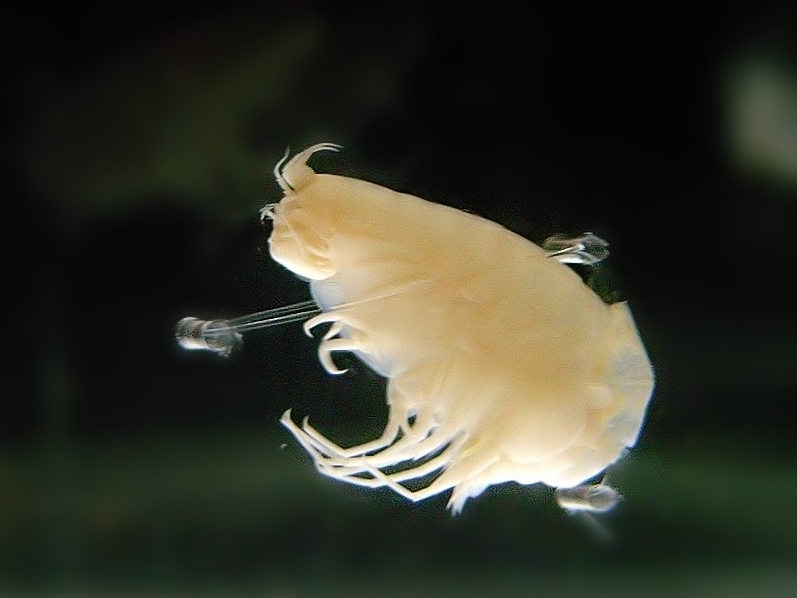
Image - Text Version
Shown is a colour photograph of a small amphipod
This microscope image is of a tiny, pale pink, shrimp-like animal. Unlike a shrimp, it has a squat body and short antennas.
Adapting to the Cold
At an average temperature of 4 degrees celsius, the deep ocean is pretty chilly! Survival at such cold temperatures means that deep-sea creatures have developed certain adaptations including slowness. Deep sea creatures are usually sluggish. This means that they typically move and breathe very slowly. This is because their bodies have evolved to lower their energy needs.
We can actually see this adaptation by looking at certain deep-living creatures. Since they do not need as much energy, unnecessary features are not there. For instance, the record-holding snailfish has transparent skin, thin muscles, a skeleton made of cartilage and no scales! Its flesh is also made up of a jelly-like substance that is less dense than water. This way, it doesn’t need to swim to stop itself from sinking.
Other Adaptations
Scientists once thought that sunlight and oxygen were absolutely necessary to create life. But in 1977, scientists discovered an ecosystem in the ocean where animals lived without these things.
Scientists had been investigatingvents. These are cracks in the ocean floor where the Earth’s opens to the hot, central layers of the planet. Water near these hydrothermal vents can reach 450 degree Celsius!
Near these vents on the ocean floor, they found a thriving community of organisms called . Extremophiles have unique adaptations that allow them to survive in the deep sea without food or oxygen. One example of an extremophile is the Giant Tubeworm. This was one of the Benthic organisms mentioned at the beginning.
Tubeworms don’t have a digestive system. Instead, scientists discovered that they contain bacteria in a special organ called the trophosome. Tubeworms and bacteria have a relationship. The tubeworm provides the bacteria a safe place to live. The bacteria uses minerals from the hydrothermal vents to create nutrients for the tubeworm.
It’s funny to think that scientists once believed the deep sea to have no life. In reality, the deep sea is the world’s largest habitat and is home to millions of species, many of which we have yet to discover!
Learn More
The Deep Sea
This animated website by Neal Agarwal will make you dive into the deep sea and meet the creatures along the way, right down to the trenches.
Creatures of the Deep Sea
This page of the Sea and Sky website has an interactive where you can learn about different creatures of the deep sea.
Deep Dive Greatest Hits
This page by NOAA has a series of videos of its exploration missions in the deep sea.
Name that deep-sea animal!
This fun quiz by the Monterey Bay Aquarium will test your knowledge and make you learn more about deep sea creatures!
Ocean Networks Canada Sights & Sounds
This page of Ocean Networks Canada offers videos and images of their deep sea observations and missions.
Ocean Encounters: A Window into the Twilight Zone (2020)
This video documentary (25:33 min.) by the Woods Hole Oceanographic Institute explains how and why it is important to study the deep sea’s twilight zone, including its role as a carbon sink.
Why Bioluminescence Evolved to Be Red Light, and Blue (2018)
This article by the Smithsonian Magazine takes a look at the evolution of bioluminescence in marine organisms.
Science Spotlight: Fish, Swim Bladders and Boyle's Law
This short video (1:03 min.) by KQED Quest uses a balloon experiment to explain the science behind Boyle’s Law.
The Fascinating World of Cnidarians
This short video documentary (11:13min.) by Nature World Facts explores the world of jellyfish, anemones, siphonophores and corals.
How do whales go on long dives?
This page from Baleines en Direct explains how whales have adapted to swim underwater for long periods of time.
References
Dive and Discover (n.d.). The Importance: A Changed “View of Life.” Woods Hole Oceanographic Institution. Retrieved from https://www.whoi.edu/feature/history-hydrothermal-vents/impacts/view.html
Dyson, M. (n.d.) Buoyancy and Depth. Open Learn. Retrieved from https://www.open.edu/openlearncreate/pluginfile.php/40130/mod_oucontent/oucontent/526/none/none/s324_4_bk4_ch4.pdf
Hall, D. (n.d.). The Deep Sea: Introduction. Smithsonian. Retrieved from https://ocean.si.edu/ecosystems/deep-sea/deep-sea
Kobayashi, H., Shimoshige, H., Nakajima, Y., Arai, W., & Takami, H. (2019). An aluminum shield enables the amphipod Hirondellea gigas to inhabit deep-sea environments. PLOS ONE, 14(4), e0206710. doi: 10.1371/journal.pone.0206710
Ponganis, P. J. and G. L. Kooyman (2006, Aug. 21). How do deep-diving sea creatures withstand huge pressure changes? Scientific American. Retrieved from https://www.scientificamerican.com/article/how-do-deep-diving-sea-cr/
Sutton, T. T. and R. J. Milligan (2019). Mesopelagic Zone. Encyclopedia of Ecology (Second Edition). Retrieved from https://www.sciencedirect.com/topics/earth-and-planetary-sciences/mesopelagic-zone